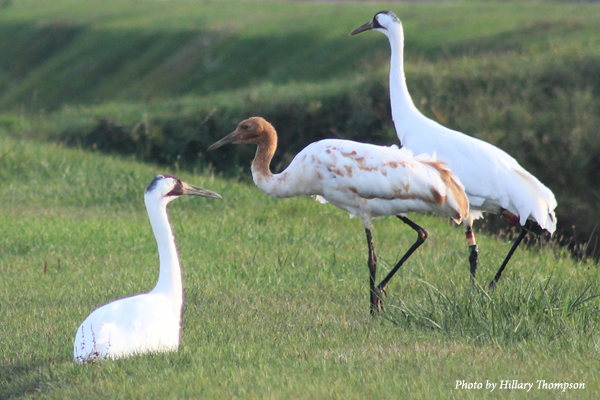
Wild-hatched Whooping Crane chick W3-17 with parents 24-09 and 42-09 in Adams County, Wisconsin prior to fall migration.
MADISON, Wis. – Sixteen young Whooping Cranes released in 2017 successfully migrated south for the winter. Restoration partners are now eagerly awaiting the birds’ return and hoping the coming breeding season exceeds the promising results achieved last year.
“We are very pleased with the good survival of last year’s released cranes and are looking forward to the return of these birds and our older cohorts,” says Trina Soyk, a biologist with the U.S. Fish and Wildlife Service who co-leads communications for the Whooping Crane Eastern Partnership leading the restoration project.
The 2017 cranes represented a mix of birds hatched in the wild, birds hatched in captivity and raised by adult cranes at the International Crane Foundation in Wisconsin and the U.S.G.S Patuxent Wildlife Research Center in Maryland, and birds hatched at Patuxent and raised by Operation Migration’s costumed handlers in Wisconsin and released over the summer into the company of adult cranes.
Partners are also keeping close tabs on a captive-reared crane released in Wisconsin last fall that did not migrate south with other Whooping Cranes. Earlier efforts to trap the bird and transport it south weren’t successful. With Whooping Cranes soon starting their return trip to Wisconsin, partners decided to let the bird remain at its wintering location. They have been providing supplemental food and checking on the young crane frequently.
“Whooping Crane 38-17 has so far successfully wintered in Wisconsin, and that’s a novel event as far as I know,” says Davin Lopez, a Wisconsin Department of Natural Resources conservation biologist working on the Whooping Crane Eastern Partnership.
Anne Lacy, Crane Research Coordinator from the International Crane Foundation, added, “It does amaze me how resilient cranes are, even in our bitterly cold winters. Their body fat reserves and down coats are built exactly for this situation. Though this is definitely a rare situation, we do not expect it to happen often.”
The 2017 breeding season yielded some exciting results: two wild chicks hatched and survived to fledge, and a young pair nested for the first time in an area biologists refer to as the Wisconsin Rectangle in the southeastern part of the state. The Whooping Crane Eastern Partnership has focused on placing birds in this area that includes Horicon Marsh and White River Marsh since 2011. Prior to that, the focus was in Juneau County in central Wisconsin, until it was discovered that biting black flies contributed to cranes and other species abandoning their nests. Partners are also conducting research in Juneau County to determine causes of chick pre-fledge mortality.
Says Operation Migration’s Joe Duff, “We are committed to finding answers that will help the Eastern Migratory Population reach a self-sustaining level.” Duff added, “This year we plan to expand the research that began in 2017 to include a greater geographic footprint, which will provide even more valuable data for evaluation by partnership scientists.”
Whooping Cranes have historically started spring migrations in February. The Whooping Crane Eastern Partnership asks anyone who encounters a Whooping Crane in the wild to please give them the respect and distance they need. Do not approach birds on foot within 200 yards; remain in your vehicle; do not approach in a vehicle any closer than 100 yards. Also, please remain concealed and do not speak loudly enough that the birds can hear you. Finally, do not trespass on private property in an attempt to view or photograph Whooping Cranes.
Whooping Crane Eastern Partnership founding members are the International Crane Foundation, Operation Migration, Wisconsin Department of Natural Resources, U.S. Fish and Wildlife Service, the U.S. Geological Survey, Patuxent Wildlife Research Center and National Wildlife Health Center, the National Fish and Wildlife Foundation, the Natural Resources Foundation of Wisconsin and the International Whooping Crane Recovery Team.
Click here to report a Whooping Crane sighting. For more information on the project and its partners, visit the Whooping Crane Eastern Partnership website.
